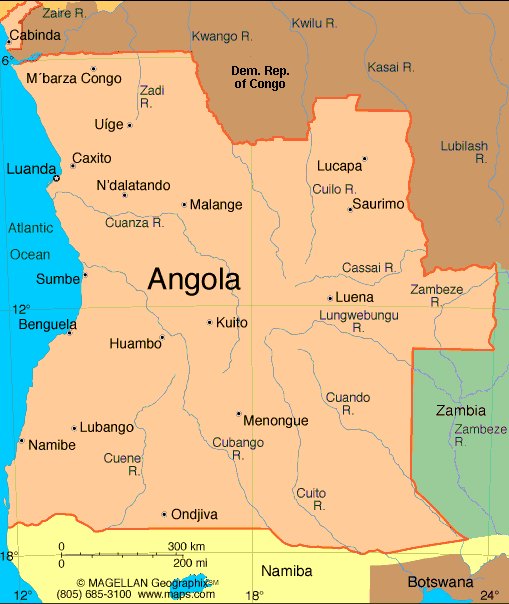Angola

Angola
Geography
Angola, more than three times the size of California, extends for more than 1,000 mi (1,609 km) along the South Atlantic in southwest Africa. The Democratic Republic of the Congo and the Republic of Congo are to the north and east, Zambia is to the east, and Namibia is to the south. A plateau averaging 6,000 ft (1,829 m) above sea level rises abruptly from the coastal lowlands. Nearly all the land is desert or savanna, with hardwood forests in the northeast.
Government
Angola underwent a transition from a one-party socialist state to a nominally multiparty democracy in 1992.
History
The original inhabitants of Angola are thought to have been Khoisan speakers. After 1000, large numbers of Bantu speakers migrated to the region and became the dominant group. Angola derives its name from the Bantu kingdom of Ndongo, whose name for its king is ngola.
Explored by the Portuguese navigator Diego Cão in 1482, Angola became a link in trade with India and Southeast Asia. Later it was a major source of slaves for Portugal's New World colony of Brazil. Development of the interior began after the Berlin Conference in 1885 fixed the colony's borders, and British and Portuguese investment fostered mining, railways, and agriculture.
Following World War II, independence movements began but were sternly suppressed by Portuguese military forces. The major nationalist organizations were the Popular Movement for the Liberation of Angola (MPLA), a Marxist party; National Front for the Liberation of Angola (FNLA); and the National Union for the Total Independence of Angola (UNITA). After 14 years of war, Portugal finally granted independence to Angola in 1975. The MPLA, which had led the independence movement, has controlled the government ever since. But no period of peace followed Angola's long war for independence. UNITA disputed the MPLA's ascendancy, and civil war broke out almost immediately. With the Soviet Union and Cuba supporting the Marxist MPLA, and the United States and South Africa supporting the anti-Communist UNITA, the country became a cold war battleground.
With the waning of the cold war and the withdrawal of Cuban troops in 1989, the MPLA began to make the transition to a multiparty democracy. Despite shifting ideologies, the civil war continued, with UNITA's charismatic rebel leader, Jonas Savimbi, armed and sustained by his control of approximately 80% of the country's diamond trade. Free elections took place in 1992, with incumbent president José Eduardo dos Santos and the MPLA winning the UN-certified election over Savimbi and UNITA. Savimbi then withdrew, charging election fraud, and the civil war resumed.
Four years of relative peace took place between 1994 and 1998, when the UN, at a cost of $1.6 billion, oversaw the 1994 Lusaka peace accord. In 1997 it was agreed that a coalition government with UNITA would be implemented. But Savimbi violated the accord repeatedly by refusing to give up his strongholds, failing to demobilize his army, and retaking territory. As a result, the government suspended coalition rule in Sept. 1998, and the country again plunged into civil war. Angola’s citizens continued to suffer. The hostilities affected an estimated 4 million people, about a third of the total population, and there were almost 2 million refugees.
On Feb. 22, 2002, government troops killed Jonas Savimbi, and his exhausted troops were ready to lay down their arms. Six weeks later, on April 4, rebel leaders signed a cease-fire deal with the government, signaling the end of 30 years of civil war. Within another five weeks, 80% of the rebels had been disarmed. While peace finally seemed secure, more than a half-million Angolans were faced with starvation. Thousands of Angolan refugees returned to their country in 2003, where their prospects are bleak.
Angola is the second-largest oil producer in sub-Saharan Africa, yet its people are among the continent's poorest. The corruption of the dos Santos government bears much of the blame. According to the International Monetary Fund, more than $4 billion in oil receipts have disappeared from Angola's treasury in the last six years.


<< Home